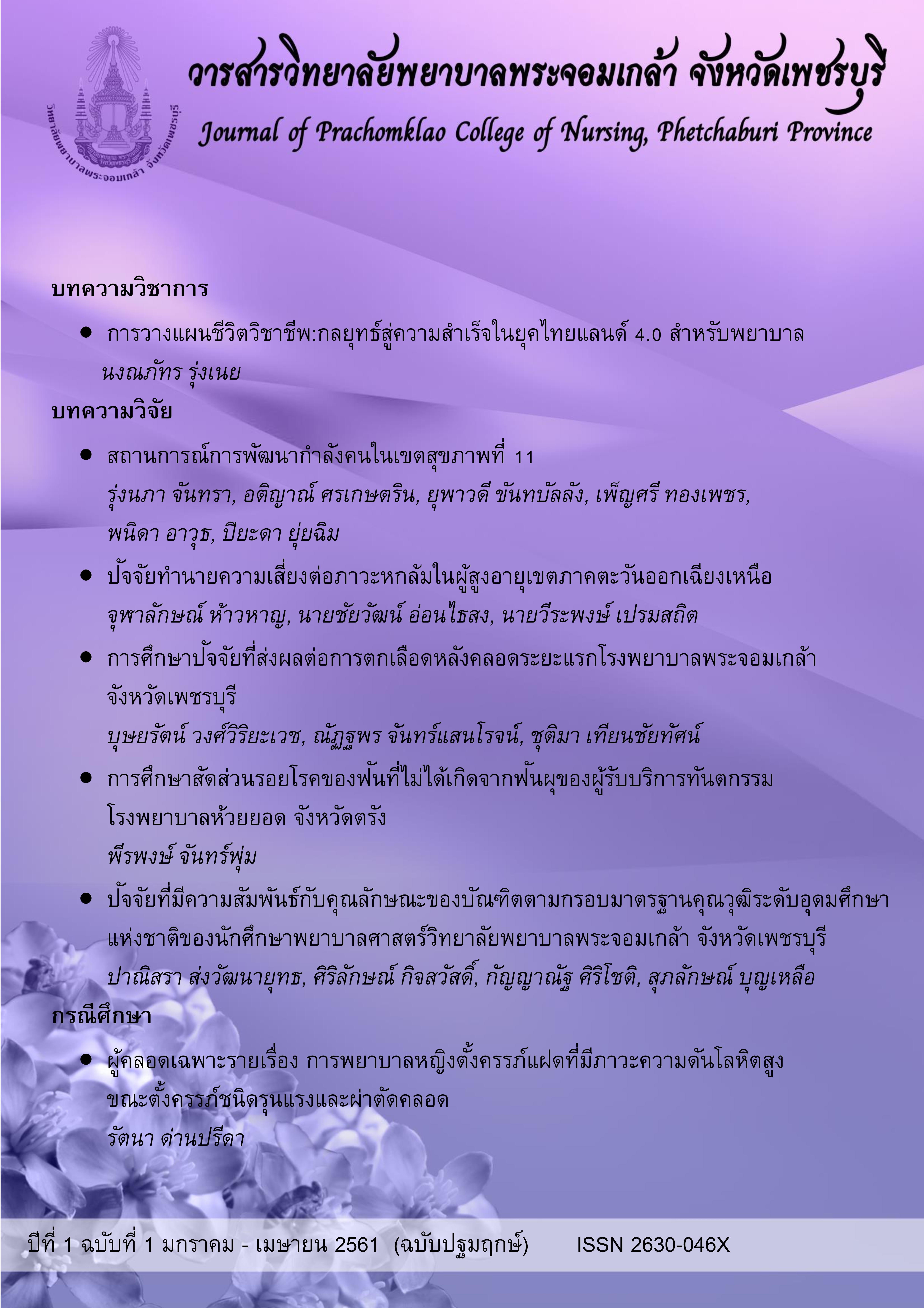การศึกษาสัดส่วนรอยโรคของฟันที่ไม่ได้เกิดจากฟันผุของผู้รับบริการทันตกรรมโรงพยาบาลห้วยยอด จังหวัดตรัง
Main Article Content
บทคัดย่อ
การศึกษานี้มีวัตถุประสงค์เพื่อศึกษาสัดส่วนของรอยโรคที่ไม่ได้เกิดจากฟันผุและศึกษาค่าเฉลี่ยต่อรายต่อห้าปีของกลุ่มรอยโรค ในกลุ่มผู้รับบริการทันตกรรม ที่มารับบริการทันตกรรม ที่โรงพยาบาลห้วยยอด จังหวัดตรัง เก็บรวบรวมข้อมูลทุติยภูมิในโปรแกรมบันทึกข้อมูล Hosxp ของผู้รับบริการทันตกรรมทุกราย ตั้งแต่ปี 2556-2560 วิเคราะห์สัดส่วนของรอยโรคของฟันที่ไม่ได้เกิดจากฟันผุโดยใช้สถิติร้อยละ และศึกษาค่าเฉลี่ยต่อรายต่อห้าปี โดยใช้ค่าเฉลี่ยเลขคณิตและค่าเบี่ยงเบนมาตรฐาน ผลการศึกษาพบว่าร้อยละของผู้รับบริการที่ได้รับการวินิจฉัยรอยโรคที่ไม่ได้เกิดจากฟันผุ พบในเพศหญิงมากกว่าเพศชาย พบในกลุ่มอายุมากกว่า 50 ปี มากที่สุด และกลุ่ม 36-50 ปีรองลงมา และรอยโรคที่ไม่ได้เกิดจากฟันผุมีค่าเฉลี่ยค่าบริการต่อรายต่อห้าปี สูงที่สุด
Downloads
Article Details
เนื้อหาและข้อมูลที่เผยแพร่ในวารสารวิทยาลัยพยาบาลพระจอมเกล้า จังหวัดเพชรบุรี ถือเป็นข้อคิดเห็นและความรับผิดชอบของผู้นิพนธ์บทความโดยตรง บทความ เนื้อหา ข้อมูล รูปภาพ ฯลฯ ที่ได้รับการเผยแพร่ในวารสารนี้ ถือเป็นลิขสิทธิ์ของวารสารฯ หากบุคคลหรือหน่วยงานใดต้องการนำทั้งหมดหรือส่วนหนึ่งส่วนใดไปเผยแพร่หรือเพื่อกระทำการใด ๆ จะต้องอ้างอิงวิทยาลัยพยาบาลพระจอมเกล้า จังหวัดเพชรบุรี ทุกครั้ง
เอกสารอ้างอิง
Chu, F. C. S., Yip, H. K., Newsome, P. R. H., Chow, T. W., & Smales, R. J. (2002). Restorative management of the worn dentition: I. Aetiology and diagnosis. Dental Update, 29(4), 162–168. https://doi.org/10.12968/denu.2002.29.4.162
Hanif. (n.d.-a). Tooth surface loss revisited: Classification, etiology, and management. Retrieved April 22, 2018, from http://www.jresdent.org/article.asp?issn=2321-4619;year=2015;volume=3;issue=2;spage=37;epage=43;aulast=Hanif
Hanif. (n.d.-b). Tooth surface loss revisited: Classification, etiology, and management. Retrieved April 25, 2018, from http://www.jresdent.org/article.asp?issn=2321-4619;year=2015;volume=3;issue=2;spage=37;epage=43;aulast=Hanif
Harpenau, L. A., Noble, W. H., & Kao, R. T. (2011). Diagnosis and management of dental wear. Journal of the California Dental Association, 39(4), 225–231.
Kaidonis, J. A. (2012). Oral diagnosis and treatment planning: part 4. Non-carious tooth surface loss and assessment of risk. British Dental Journal, 213(4), 155–161. https://doi.org/10.1038/sj.bdj.2012.722
Litonjua, L. A., Andreana, S., Bush, P. J., & Cohen, R. E. (2003). Tooth wear: attrition, erosion, and abrasion. Quintessence International (Berlin, Germany: 1985), 34(6), 435–446.
López-Frías, F. J., Castellanos-Cosano, L., Martín-González, J., Llamas-Carreras, J. M., & Segura-Egea, J. J. (2012). Clinical measurement of tooth wear: Tooth wear indices. Journal of Clinical and Experimental Dentistry, 4(1), e48–e53. https://doi.org/ 10.4317/jced.50592
Smith, B. G., Bartlett, D. W., & Robb, N. D. (1997). The prevalence, etiology and management of tooth wear in the United Kingdom. The Journal of Prosthetic Dentistry, 78(4), 367–372.
TheEtiologyEH.pdf. (n.d.). Retrieved 1 April 25, 2018 from http://www.buildyoursmile. com/pdfs/ TheEtiologyEH.pdf


